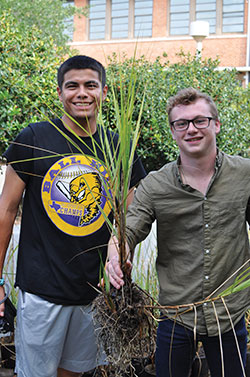This year, Galveston Bay Foundation (GBF) welcomed two new schools – Ball High in Galveston and St. Thomas Episcopal School in Houston – to “Get Hip to Habitat,” our school-year long wetland education and restoration program.
Ball High: Galveston, TX

“It was really hard work at first,” said Christian Mays, a senior at Ball High who had spent the class period consolidating marsh grass and cleaning out the kiddie pools.
“It seemed like a chore, but I found myself learning more and more every day. We’re actually able to help out these marshes with human power instead of waiting for nature to take its course,” he said.
He said it feels awesome to do the project for Galveston, where he is from, and to help out the environment and wildlife.
Ball High is a Title I school and received a scholarship to participate in the program, a resource teacher Zahrah Ektefaei was thankful for, as she said they would not be able to otherwise.
It’s this kind of hands-on science experience that helps create adults who value and are concerned for the health of the Bay,” she said.
She said because of their experience in the program, she has had students express interest in pursuing degrees in biology and environmental science, an outcome she did not think would be the same if they were just hearing about science instead of getting to participate in the process.
“It’s especially helpful that we get to participate in a hands-on project,” echoed Carter Burlison, a senior in Ms. Ektefaei’s class. “If we keep up this marshland, it will provide provide food and shelter for habitat in the Bay.”
St. Thomas Episcopal School: Houston, TX

“Over the year, the students have been bonding while developing a sense of responsibility and a greater understanding of our watershed and the significance of wetlands,” she said.
Edmund Carroll, senior in Ms. Maw’s class, said the program helped give the class a sense of accomplishment, a chance to get outside and experience nature – which he says is becoming a rarity, and an understanding of the importance of the project beyond just planting grass.
“For Houstonians, flooding and loss of wetlands is a very real and immediate problem,” he said. “It is imperative to be able to participate in this program in order to save our ecosystem, our livelihood and our culture, if not our lives.”
For more information about GBF education programs, visit www.galvbay.org/education.

